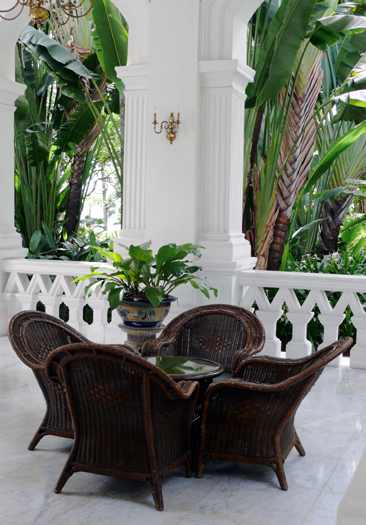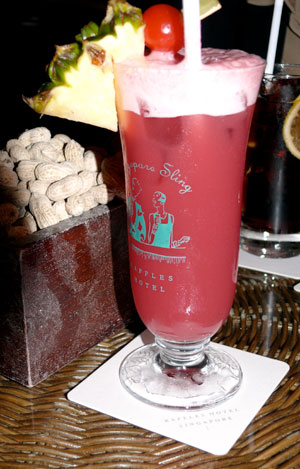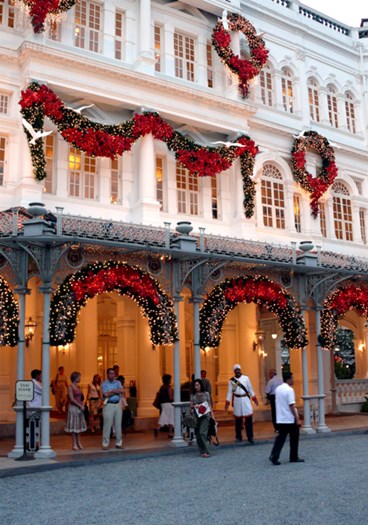SINGAPORE — Few hotels employ a resident historian. But then again, few hotels are as historically significant as this city's famed Raffles.
Leslie Danker, the historian, pulls his slight frame onto a stool in Raffles' Writers Bar and tells a scribe all there is to know about this, the most famous hotel in Asia -- a place where many of the suites are named after the famous writers who once sat where Danker is now perched.
Rudyard Kipling, Somerset Maugham--"Oh yes, all the great writers have stayed here," Danker informs an eager listener.
"Somerset Maugham stayed with us three times and it was here that Kipling wrote From Sea to Sea," says the man who has held his present job for 34 years and leads twice-a-day tours of the palatial property now registered as a national monument.
The colonial-style landmark, recently purchased by the prestigious Fairmont chain, was first opened in 1887 by three Armenian brothers -- the Sarkies -- as a 10-room bungalow off Beach Road "when there was still a beach here," says Danker about an area of Singapore where reclaimed land has pushed the water's edge well away from Raffles' main entrance.
The hotel, named after Singapore's founder, an Englishman named Sir Stamford Raffles, is a place where not just famous authors, but a who's who list of nobility, including Britain's Queen Elizabeth, and the kings and queens of stage and screen, have stayed while visiting this intriguing city-state.
If only the walls could talk in this hotel. But who needs walls when Danker is only too eager to reveal Raffles' secrets to a stranger.
"Come with me," says Danker as I follow him onto the handsome white porch that wraps around the front of the hotel. The man who first started here as a bellboy and is now called upon to educate new staff "because new employees must appreciate and understand the history of Raffles to enjoy working here," leads me up a main floor ramp and into a room filled with billiard and dining tables.



Left: Hotel retains its colonial charm. Centre; Hotel invented the Singapore Sling. Right: Christmas in the topics.
"This is the famous Bar and Billiard room," says Danker.
"Did you know why it's famous?" asks Danker, who doesn't give me a chance to answer before continuing.
"Because this is where a tiger was shot and killed -- right under this billiard table."
The story goes: One day in 1902 "the last wild tiger in Singapore" ran into the then open-air billiard room, was cornered under the gaming table and then shot by a "brave" patron.
At least that's the official story. Danker has a different version.
"The frightened tiger actually belonged to a native show but had wandered off and sought refuge under one of the tables. It was shot and killed by an overzealous drinker.
"It was like shooting fish in a barrel," Danker laments.
The next place Danker shows me is the legendary Long Bar on the hotel's second floor where the famous Singapore Sling cocktail was first poured by an inventive barman named Ngiam Tong Boon in 1910.
"Boon's original Sling recipe is safely locked away in one of our museum's display cases," says Danker, who insists we try one of the potent pink-colored drinks--originally created to lure more females into the Long Bar--before heading to the third floor museum.
The Long Bar has become one of the most popular gathering spots in Singapore with tourists. Large ceiling fans cool customers who crack peanuts and then discard shells onto the floor -- the only place in squeaky-clean Singapore where littering is allowed.
The three-tiered arcade where the hotel's bars, some restaurants, high end shops and museum are located, overlooks Raffles' courtyard where fountains and palm trees cool those who seek shelter from Singapore's sweltering heat.
Danker lowers his voice as we enter the museum, located across from the hotel's beautifully-decorated 388-seat Victorian theatre.
"The museum opened three and a half years ago," says my guide as we scan the rooms filled with weathered photographs of former guests, old trunks and suitcases, and many books that either refer to Raffles or were written in the hotel by the likes of Kipling.
"When word got out that we were starting the museum, former guests sent us artifacts and each year we receive more and more," notes Danker.
On the way back to the Writers Bar, located off the hotel's sun drenched plantation-like lobby, the historian points to one of the 12 suites named after famous guests of years past. Raffles only offers suites - 103 in all. They come stuffed with comfy overstuffed furniture, modern electronic features, and a butler, who tends to a guest’s every command.
Tropical hardwoods and exquisite carpets -- over 700 handmade Persian masterpieces, to be exact -- are featured in the rooms and public areas and give Raffles that homey feel.
"That's why we get so many repeat guests," says Danker. "They feel like this is home, their residence."
Over 70 per cent of Raffles' guests are of the leisure variety, but the hotel is adding more features to attract business clients.
Raffles is also home to some of Singapore's best-reviewed restaurants, where the city state’s rich and powerful often gather to do business or simply unwind. A top among that impressive list is Raffles Grill, where fine French cuisine is accented with the freshest tropical fruits and vegetables.
Danker insisted we poke our heads into the Grill, which overlooks the hotel's lush tropical gardens. A large silver serving dish sitting on a cart, one big enough to hold an oversized turkey, caught my eye as we looked around the impressive room.
Without hesitation, the informative Danker had another story at the ready detailing yet another aspect of the hotel’s history.
"During World War II, Singapore was occupied by the Japanese military, which made Raffles its headquarters. The serving dish was one of the hotel's original pieces and staff feared it would be taken by the Japanese when they left. So they buried it in the hotel garden until after the war," Danker tells me. "It now stands as a symbol of freedom."
After the war, Raffles was used as a transit camp for prisoners and then in 1987, the government declared it a national monument. In 1989, the hotel was closed during a two-year refurbishment project, one that added the arcade, brought the hotel up to modern standards but, in looks, returned it to its glory days of the late 1800s.
One of the great traditions at Raffles, Danker tells me, is the annual New Year's Eve party.
"It's held in the main lobby," says the historian, "and families come from many different countries to be part of the tradition."
The lobby is bathed in natural light and accented with colonial furniture and large floral displays. Tropical birds, which sneak in when the doors are opened fly freely about the distinguished entrance with the gleaming white marble floors.
The jovial doormen, in their traditional Singaporean garb, are often asked to stand straight and tall and have their photographs taken with giggling tourists. They're always accommodating, especially to those who are not staying at Raffles.
"Raffles is as much an historic site as anything in Singapore," says Danker
"And we're very proud of that. Raffles is a wonderful story and people love to hear all about it."
Thanks to Danker, Raffles is a piece of living history that just keeps getting better with age.